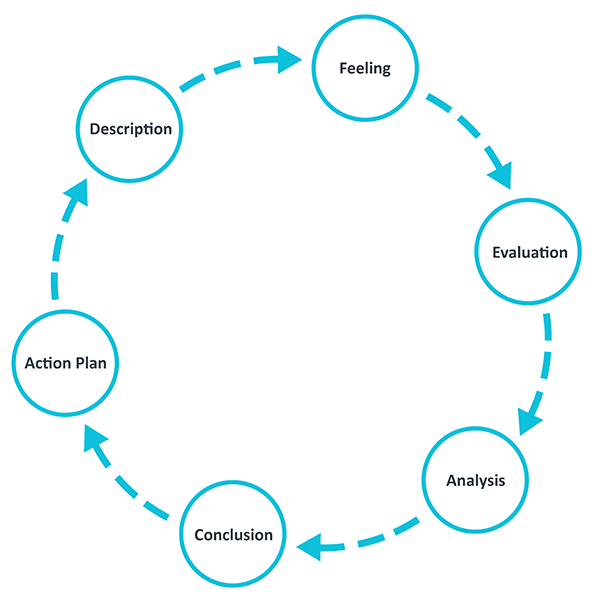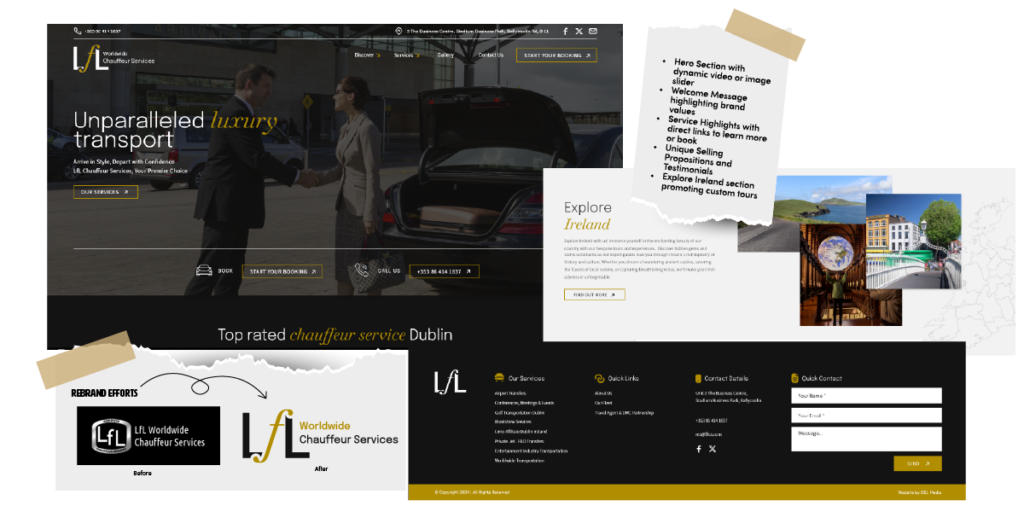Throughout the course of the Reflective Practise module I will be working on self-improvement and professional development which will involve frequent reflection on my work and processes. Reflective models serve as guiding frameworks. In this blog post, I will explore the significance of reflective models.
Understanding Reflective Models:
Following a session from Laura she explained three different reflective models that could aid our reflective practise module. These three methods were Kolb’s Experiential Learning Cycle, Gibbs’ Reflective Cycle, and Boud’s Model of Reflection. Kolb’s model, with its stages of Concrete Experience, Reflective Observation, Abstract Conceptualisation, and Active Experimentation, emphasises a holistic and hands-on approach to learning. Gibbs’ cycle includes Description, Feelings, Evaluation, Analysis, Conclusion, and Action Plan this model emphasises a more detailed exploration of emotions and actions during an experience. Boud’s Model highlights the importance of returning to experiences with a critical lens, encouraging a deeper understanding of personal and professional contexts. Each model contributes unique perspectives to the reflective process and provide a systematic framework to enhance learning and personal growth.
For my reflections I have opted to use the Gibbs’ Reflective Cycle
Gibbs’ Reflective Cycle, conceived by Graham Gibbs in 1988, serves as a structured tool for learning from experiences. This framework is designed to provide a systematic approach to examining various situations, making it especially beneficial for recurring experiences explains (Gibbs’ reflective cycle 1970). Its cyclic nature facilitates learning and planning from both successful and challenging encounters. The cycle unfolds across six stages, guiding individuals through a comprehensive reflection process to enhance their understanding and promote continuous improvement.

Practising Using The Gibbs Model For Previous Work:
I tried out using the Gibbs Model on a recent project I had worked on:
Project Description :
To create a modern and functional website for LFL Chauffeur Services. My tasks involved developing a design concept to be built into a comprehensive WordPress website for LFL, focusing on providing a unique, informative, and visually appealing experience for users. The website will include a blog and be optimised for responsiveness, ensuring seamless viewing across all devices. Strong calls-to-action (CTAs) and visual content will be utilized to drive user engagement and interest.
- Utilise a responsive design for compatibility across all devices.
- Implement strong calls-to-action (CTAs) and visual content to drive user engagement.
- Create distinct sections for each target market, maintaining a professional and welcoming tone.
- Incorporate testimonials and interactive booking forms for user trust and ease of use.
- Design a modern, intuitive navigation structure for seamless browsing.
- Redesign header and footer for improved navigation and visibility.
Feeling :
At the outset of this project, I found myself apprehensive due to the prospect of working with potentially fussy clients who had provided lackluster and uninspiring competitor sites as references. Initially, this left me feeling uncertain about the direction the design process might take and concerned about meeting the clients’ expectations.
However, my outlook shifted significantly after looking for my own design inspiration. Exploring various websites and design portfolios outside of the chauffeur services industry, I stumbled upon innovative and visually captivating designs that sparked my creativity. Witnessing the diverse range of possibilities and the potential for unique, engaging designs filled me with optimism for the upcoming design process whilst also keeping in mind the specification and websites provided by the client.
Evaluation :
The design process involved extensive collaboration and feedback from colleagues, leading to multiple rounds of refinement to ensure the final product met the clients standards. Despite the back and forth, I am pleased with the outcome. The collective effort resulted in a design that not only meets the client’s expectations but also surpasses them, reflecting our commitment to excellence.
Analysis :
| Strengths : | Opportunities: |
| Collaboration and feedback with colleagues Attention to detail Prioritising user experience | Enhancement of the clients brand Improved engagement Competitor advantage |
| Weaknesses : | Threats: |
| Time consuming Resource intensive | Change in trends Negative client feedback Technical challenges |
Conclusion :
To summarise, the process of building the website for LFL Chauffeur Services has been gratifying and educational. Despite initial concerns about customer preferences and boring competition websites, the project turned out to be a showcase of cooperation, innovation, and dedication. The design process resulted in a final product that not only met, but exceeded expectations, thanks to thorough planning, significant research, and iterative refinement. The website now stands out as a symbol of elegance, professionalism, and user-centricity, demonstrating the brand’s dedication to quality in all aspects of its services. From collaborative brainstorming sessions to precise attention to detail in the final design, every stage of the process was defined by a shared dedication to producing the final design.
Action Plan :
Looking ahead, the website will help LFL Chauffeur Services boost its brand image, engage clients, and differentiate itself in a competitive market. Using this method to the design process will benefit me since collaboration allows for the addition of fresh ideas and viewpoints, and everyone engaged can guarantee that nothing is missing when compared to the client’s specifications. I will also ensure that I action interactive prototypes so that GSL can advance its concept delivery to client’s and demonstrate not only how it will look but also how it will function.

Why Will I Be Using The Gibbs Method?
The Gibbs Reflective Cycle is effective for me because of its structured approach, which divides reflection into six stages: description, feelings, evaluation, analysis, conclusion, and action plan. Its circular nature allows for repeated experiences, promoting continuous learning from both successes and challenges. This method will help to create a balanced understanding of my actions by providing an organised structure.
References:
Gibbs’ reflective cycle (1970) The University of Edinburgh. Available at: https://www.ed.ac.uk/reflection/reflectors-toolkit/reflecting-on-experience/gibbs-reflective-cycle#:~:text=One%20of%20the%20most%20famous,analysis%2C%20conclusion%20and%20action%20plan. (Accessed: 06 December 2023).
Succeeding in postgraduate study (no date) Open Learning. Available at: https://www.open.edu/openlearn/mod/oucontent/view.php?id=51386§ion=4 (Accessed: 06 December 2023).